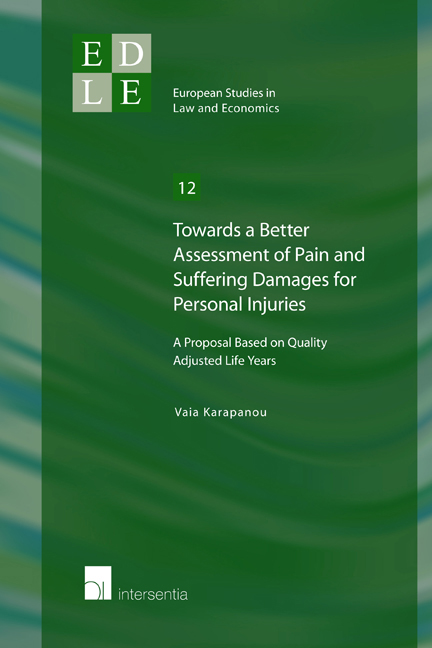 Towards a Better Assessment of Pain and Suffering Damages for Personal Injuries
Towards a Better Assessment of Pain and Suffering Damages for Personal Injuries Book contents
- Frontmatter
- Acknowledgements
- Contents
- Table of Cases
- List of Abbreviations
- List of Tables and Figures
- Chapter 1 Introduction
- Chapter 2 How Should Pain and Suffering Damages be Assessed? A Legal Perspective
- Chapter 3 How Should Pain and Suffering Damages be Assessed? A Law and Economics Perspective
- Chapter 4 Quality Adjusted Life Years. A Measure for the Economic Evaluation of Health Care
- Chapter 5 Using QALYs in a Tort Law Context. Assessing Pain and Suffering Damages
- Chapter 6 Pain and Suffering Damages Based on QALYs. Circumventing Victims' (and Judges') Hedonic Misperceptions
- Chapter 7 The QALY Framework Applied. Practical Examples and Implementation Recommendations
- Chapter 8 Epilogue
- Bibliography
- About the author
- EUROPEAN STUDIES IN LAW AND ECONOMICS
Chapter 7 - The QALY Framework Applied. Practical Examples and Implementation Recommendations
Published online by Cambridge University Press: 22 November 2017
- Frontmatter
- Acknowledgements
- Contents
- Table of Cases
- List of Abbreviations
- List of Tables and Figures
- Chapter 1 Introduction
- Chapter 2 How Should Pain and Suffering Damages be Assessed? A Legal Perspective
- Chapter 3 How Should Pain and Suffering Damages be Assessed? A Law and Economics Perspective
- Chapter 4 Quality Adjusted Life Years. A Measure for the Economic Evaluation of Health Care
- Chapter 5 Using QALYs in a Tort Law Context. Assessing Pain and Suffering Damages
- Chapter 6 Pain and Suffering Damages Based on QALYs. Circumventing Victims' (and Judges') Hedonic Misperceptions
- Chapter 7 The QALY Framework Applied. Practical Examples and Implementation Recommendations
- Chapter 8 Epilogue
- Bibliography
- About the author
- EUROPEAN STUDIES IN LAW AND ECONOMICS
Summary
The assessment of pain and suffering damages as it is currently performed in many countries does not seem to take into account all the crucial elements that would allow the objectives of tort law and of the economic analysis of tort law to be attained. The preceding analysis clearly demonstrated that there is a large scope for improvement, which could be achieved by utilizing a measure that has been used so far to evaluate health treatments and medical interventions.
The proposed QALY approach can take into consideration elements that are important for the attainment of compensation and satisfaction, such as the intensity of the pain, the type, severity and duration of the injury, the loss of life expectancy, and the personal characteristics of the victim, and express them in the resulting awards in a predictable and consistent manner. Moreover, the QALY can offer the missing framework to estimate the ex ante determined damages; it can set the damages so as to ensure that the injurer correctly internalizes the costs the victim would be willing to pay and that the victim is not over-insured against her will. By treating immaterial losses arising from personal injuries in a way that is consistent with both deterrence and insurance considerations, the suggested framework can therefore strike a balance between the two goals with respect to the treatment of immaterial losses. Besides the abovementioned advantages of the QALY, chapter 5 also explained that the proposed approach is expected to result in a decrease in litigation costs and to facilitate speedier adjudication, consequently enhancing the overall reliability of the judicial system. Finally, chapter 6 examined whether, under certain conditions, the QALY framework could be able to address the possibility that victims (and judges) disregard the gradual improvement in life satisfaction after an adverse event due to hedonic adaptation and focusing illusion and thus claim for (or decide in favor of) a higher damage award than what would correspond to the actual losses incurred. If additional empirical evidence were indeed to corroborate that these misperceptions occur regularly, and at the same time legal scholarship were to reach the conclusion that they should be accounted for in the assessment of pain and suffering damages, then the proposed QALY framework could perform this task.
- Type
- Chapter
- Information
- Towards a Better Assessment of Pain and Suffering Damages for Personal InjuriesA Proposal Based on Quality Adjusted Life Years, pp. 173 - 204Publisher: IntersentiaPrint publication year: 2014


